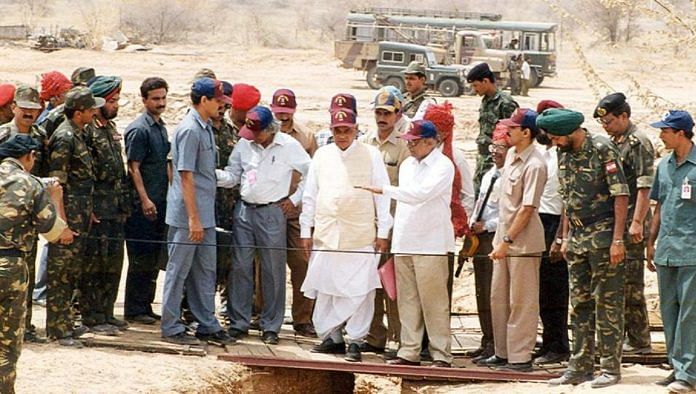
Thank you dear subscribers, we are overwhelmed with your response.
Your Turn is a unique section from ThePrint featuring points of view from its subscribers. If you are a subscriber, have a point of view, please send it to us. If not, do subscribe here: https://theprint.in/subscribe/
For those who question what India did till now, and the one who thinks that India got Independence in 2014, they should know that India constructed Asia’s 1st research reactor named Apsara in 1954.
Both Pt. Nehru and Homi Jehangir Bhabha from day one wanted to have nuclear weapon. And after the war with China in 1962 and two years later when China successfully tested their nuclear weapon, the urgency of India to pursue their dreams as soon as possible was unavoidable. But the reluctance of Lal Bahadur Shastri and his death in 1966 followed by the unprecedented demise of Homi Jehangir Bhabha in an airplane crash at an interval of just 13 days, pushed our plans a bit further.
Before Bhabha’s death, he helped India to have its nuclear power programme designed in 1958 with 3 stages. With this Nuclear power programme, in 1962 an agreement signed between India and USA, under which General Electric company supplied two boiling water nuclear reactors for Tarapur in Maharashtra, and enriched uranium of 2.5% was used as a fuel. But both Bhabha and Nehru were aiming for nuclear bombs and they knew that USA will stop the supply of enriched uranium after the completion of nuclear test.
So, by keeping that prospect in mind India signed an agreement with Canada in 1965 for pressurized heavy water reactor in Rawabhata, Rajasthan, which will use natural uranium as a fuel, and that can be mined in India only.
Era of Indra Gandhi
Indra Gandhi was 180 degrees opposite to his father Pt. Nehru. In foreign affairs whenever conflict had arisen, the tackling culture of Nehru was “come on the table and let’s talk,” and the same for her daughter was “our military will go and talk.” She took India decisively towards USSR. Indra Gandhi left aside the non-align movement, which was designed by her father and signed Indo-soviet Treaty of Peace, Friendship and Cooperation in 1971, that allowed India to come under nuclear umbrella of USSR which assured that if a nuclear threat arises from anywhere, USSR is bound to protect.
Operation Buddha Smiling
In 1974, the executive decision to test the nuclear weapon was taken, but the plot was not set. If USA or their supporting allies had known about the plan as they found out in 1996, they would have done whatever it takes to stop India from conducting the test.
The secrecy of the programme was such that only five people were knowing about the plot. Indra Gandhi herself, R.K Dhawan her personal secretary, Cabinet Secretary, Homi Sethna and Raja Ramanna. The last two names are of the India’s top nuclear scientists. Venue was to be decided between Ladakh and Pokhran, and Pokhran was finalized.
The major challenge
The bone of contention was how the material of nuclear test will reach to Pokhran from Trombey. Then, the top 2 nuclear scientist decided to let their names to be written with golden letters in history and they took the responsibility of transporting the nuclear stuff.
Pokhran, a village in Rajasthan, where no airstrip, no railways line is existing, Raja Rammana and Homi Sethna covered more than 1000 kilometres in an army truck, where there was no concept of highways at that time, condition of roads was next to unimaginable. But the zeal to make India as a nuclear state, surpassed all the obstacles. They are the pioneers of building a resilient India and an example for those kiddish officers who demands chartered plane for anything and everything.
Digging of pit
Both scientists requested army to dig a pit, reason was given that they have to check whether water was present there in Pokhran or not, and unluckily they found water there. So, they again requested army to dig another pit and then the nuclear stuff was implanted on the day of Buddha Purnima. And finally, Buddha smiled. A total of 3 explosion took place.
Informing to New Delhi
In an era of no mobile phones, Raja Ramanna took a Bicycle from the village and travelled several kilometres to fetch a telephone booth and gave a call to South block, Raisina hills, Delhi and informed that finally Buddha has smiled.
I Wrote this article because, today if our leaders in the international forum are telling this to the western world that “do not bargain with us in our foreign policy by giving China’s fear, India can defend itself.” It is because of the sacrifice, these superhumans did, and in this WhatsApp university, these stories have somewhere lost and have been captured by the right-wing leaders, whose ancestors never participated in any of the freedom struggle and after independence they shouted from the highest pitch of their voice that we are the true rashtra-bhakts and taught history to the masses according to their whims and fancies.
Also read: SubscriberWrites: ‘Democracy 2.0’ — A new definition of democracy is needed in changing times
These pieces are being published as they have been received – they have not been edited/fact-checked by ThePrint.

COMMENTS